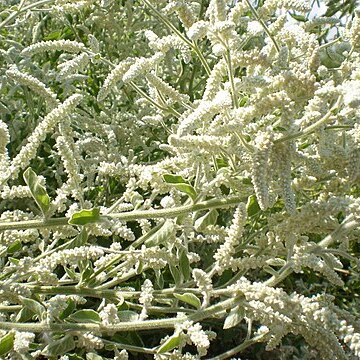Perennial herb, woody below, erect or low-spreading, 0.5-1.2(-1.5) m high. Stems arising from base, simple or branched; ± densely tomentose with whitish hairs. Leaves alternate, broadly elliptic to linear-oblanceolate, 16-100 x 5-30(36) mm, shortly cuneate at base, apex obtuse to very acute, moderately pilose on both surfaces; petioles up to 15 mm long. Inflorescence a terminal panicle of simple or branched, spikes. Flowers hermaphrodite, female or functionally male; tepals ± densely lanate dorsally; outer 2 tepals hyaline, inner 3 tepals slightly shorter and narrower. Female flowers with linear stigmas, somewhat shorter than style; anthers absent, filaments reduced. Male flowers with stigmas very reduced or absent; anthers longer. Fruit a circular capsule, 1 mm in diam. Seeds black, shining.
Tepals more or less densely lanate dorsally, more or less similar in all types of flower; outer 2 tepals hyaline, elliptic-oblong, (1.5) 2–2.5 mm. long, with a sharp mucro formed by the excurrent nerve; inner 3 tepals slightly shorter and narrower, acute with a central green vitta which extends for about three-quarters the length of each tepal and is often more or less furnished with a thickened border.
Leaves alternate, broadly elliptic to linear-oblanceolate, those of the main stem c. 1.6–10 × 0.5–3 (3.6) cm., shortly cuneate to attenuate and more or less petiolate at the base with a petiole up to c. 1.5 cm. long, rather obtuse to very acute at the apex, moderately to thinly pilose on both surfaces or more sparsely so above, leaves of the branches and inflorescence reducing upwards.
A herb. It is 100-130 cm high. It often branches near the top. It is woolly and keeps growing from year to year. The leaves are alternate. The leaf blade is 5-8 cm long. It is egg shaped and tapers to both ends. They are dull green and covered with hairs. The flowers are small and white or yellow-white and in dense spikes. These are 2 cm long. The fruit is a small, dry capsule.
Ultimate spikes white, dense or occasionally laxer and more elongate, 0.6–5 (8) × 0.4–1.2 cm., divergent or ascending; bracts 1.25–1.75 mm. long, deltoid-ovate to oblong-ovate, hyaline with a short or longer arista formed by the excurrent midrib, pilose, persistent; bracteoles similar or slightly smaller, also persistent.
Perennial herb (apparently sometimes flowering in the first year), frequently woody below, erect or low-spreading to prostrate or occasionally more or less scrambling, 0.5–1.2 (1.5) m., with numerous stems arising from the base, stems simple or branched with short or long, ascending, slender branches.
Perennial herb, up to ± 1 m high; hermaphrodite. Stems erect to procumbent, occasionally scrambling; whitish hairy. Leaves alternate; blade broadly elliptic to narrowly obovate, 10-100 x 5-30 mm. Flowers: in a spike running into a terminal leafless panicle, white-woolly; perianth white; Nov.-May.
Inflorescence variable; always with a leafless lax or compact terminal panicle of simple or branched, sessile or pedunculate spikes, the upper leaf axils for a variable length of the stem with similar pedunculate panicles, or these reduced to a sessile, simple sometimes lobed spike or spikes.
Male flowers with the stigmas very reduced or absent and only the truncate apex of the style slightly papillose, occasionally with short and apparently receptive stigmas but setting no seed; anthers longer.
Hermaphrodite flowers with stigmas usually (but not invariably) shorter than the females, and anthers often somewhat smaller than in the males.
Female flowers with linear stigmas somewhat shorter than or subequalling the style, divergent or suberect; anthers absent, filaments reduced.
Robust herb, up to 1 m high. Inflorescences spikes running into terminal leafless panicles. Flowers white.
Stem and branches terete, striate, more or less densely tomentose or lanate with whitish hairs.
Flowers hermaphrodite, female or functionally male.
Capsule and seeds as in A. lanata.

